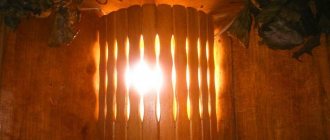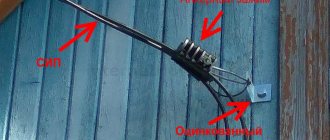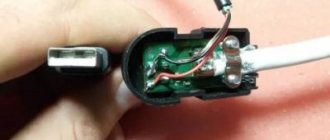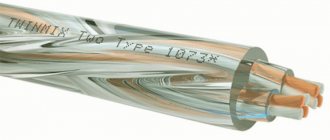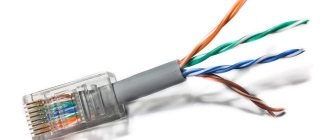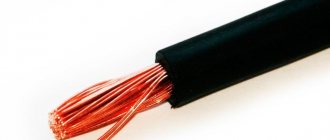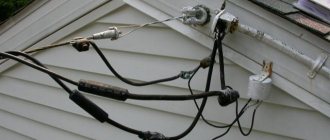Advantages and vulnerabilities of underground electrification
Supplying electricity underground
Introducing an electrical cable into a house underground instead of overhead lines has a number of advantages:
- does not spoil the architecture and design of the site;
- does not experience atmospheric influences;
- high fire safety.
In addition, eyeliner made in this way is protected from theft and vandalism. This is especially important if the building remains unattended for a long time.
Underground installation of electrical cables has some disadvantages:
- may be subject to mechanical stress during the process of swelling and subsidence of the soil;
- the influence of groundwater, soil freezing, pressure from the roots of large trees;
- Insects and rodents can damage the wiring;
- it is susceptible to aging and corrosion.
The durability of electrical wiring depends on the composition of the soil and its saturation with water, thermal fluctuations and vibration processes.
Rules for underground installation of corrugated wires
Most often, a cable with VBBbShv or AVBbShv tape armor is laid in the ground. The use of armor with a solid cast aluminum protective shell is optional; It is allowed to use tapes laid with an overlap.
They start by drawing a diagram on the site plan with the alignment of the route to stationary landmarks. In the future, the document will help to carry out excavation work correctly without damaging the line.
When placed in parallel, the following distances are maintained between the conductor and other cables:
- if both are control - not standardized;
- if at least one of them is power - 10 cm;
- if the adjacent line belongs to another owner - 50 cm.
Obtaining permission for underground input
First, you need to complete the project. It should be developed by a specialist. Technical documentation, plans and drawings must comply with all rules and regulations. The designer determines the brand of cable and calculates the cross-section of the conductors.
To receive a project, a number of technical conditions must be met. To connect a house to a common power line, you will need appropriate permission. For example, an agreement for excavation work is drawn up by the service responsible for facilities and communications.
Then the land plot is traced. If there are any communications in the immediate vicinity of the cable being laid, it is necessary to invite their representative to coordinate the position of the trench and control the work being carried out.
Technical parameters of pipes
When manufacturing any type of hoses, strict compliance with all requirements and characteristics is a prerequisite. These requirements are clearly stated in specific documents. For example, GOST 16338 defines the requirements for the manufacture of pipes made of low-pressure plastic with markings 271, 273, 276, 277, and 286. And GOST 16337 refers to products marked as - 10803-020, 15303-003, 15803-20, 16803-170.
Additionally, violation of the integrity of layers, swelling, cracks or other material defects is not allowed.
Important! The appearance of roughness on the internal walls is not allowed. It is also not permissible to violate the uniformity of the outer layer, both on corrugated and smooth HDPE pipes.
The following is an assortment of round pipes, which are presented on the Russian market.
Range of HDPE technical pipes
| SDR9 | SDR11 | SDR13.6 | SDR17 | SDR17.6 | SDR21 | SDR26 | |
| External Diameter | Product wall thickness in mm | ||||||
| 16 | 2,0 | ||||||
| 20 | 2,3 | 2,0 | |||||
| 25 | 2,8 | 2,3 | 2,0 | ||||
| 32 | 3,6 | 3 | 2,4 | 2 | |||
| 40 | 4,5 | 3,7 | 3 | 2,4 | 2 | ||
| 50 | 5,6 | 4,6 | 3,7 | 3 | 2,4 | 2 | |
| 63 | 7,1 | 5,8 | 4,7 | 3,8 | 3,6 | 3 | 2,5 |
| 75 | 8,4 | 6,8 | 5,6 | 4,5 | 4,3 | 3,6 | 2,9 |
| 90 | 10,1 | 8,2 | 6,7 | 5,4 | 5,2 | 4,3 | 3,5 |
| 110 | 12,3 | 10 | 8,1 | 6,6 | 6,3 | 5,3 | 4,2 |
| 125 | 14 | 11,4 | 9,2 | 7,4 | 7,1 | 6 | 4,8 |
| 140 | 15,7 | 12,7 | 10,3 | 8,3 | 8,0 | 6,7 | 5,4 |
| 160 | 17,9 | 14,6 | 11,8 | 9,5 | 9,1 | 7,7 | 6,2 |
| 180 | 20,1 | 16,4 | 13,3 | 10,7 | 10,2 | 8,6 | 6,9 |
| 200 | 22,4 | 18,2 | 14,7 | 11,9 | 11,4 | 9,6 | 7,7 |
| 225 | 25,2 | 20,5 | 16,6 | 13,4 | 12,8 | 10,8 | 8,6 |
| 250 | 27,9 | 22,7 | 18,4 | 14,8 | 14,2 | 11,9 | 9,6 |
| 12,3 | 10 | 8,1 | 6,6 | 6,3 | 5,3 | 4,2 | |
Cable product compliance
To supply electricity to the house, use products designed for installation in the ground. Since the electric cable will be under pressure from the mass of the soil, products in a special braid and armor are used. These are brands such as VB bShV and VB bShVng. The first letter in the marking indicates the presence of copper conductors. The armor is made with corrugated steel tape. It is wound in the form of a spiral along the inner layer of insulation.
The products are resistant to mechanical damage. Installation can be done without piping. However, to avoid damage during operation, it is recommended to use a pipe. If the ground has increased chemical activity - salt marshes, swamps, slag, construction waste - a cable with lead armor or an aluminum sheath is used.
Considering the complexity of installation work, it is better to immediately choose a high-quality cable, even if it costs more.
Which conductor is best to use for installing underground electrical lines?
Installing an underground power line requires considerable effort and time. In order not to suffer in the future with constant repairs, it is better to immediately choose a high-quality wire that will be able to properly perform its function for many years. Therefore, the issue of selecting a cable that will be used for laying underground should be approached with maximum responsibility.
Using an armored cable from a reliable manufacturer, you can be sure of its proper and durable operation. However, the cost of such a conductor is quite high, and if a person cannot afford such a purchase, he uses simple wires of the NYM or VVG brand. To increase the reliability of such lines, you should use a double-walled corrugated hose DKS, into which the electrical wire is placed along its entire length.
In places where the likelihood of damage to wiring due to heavy loads is quite high, protective cases are recommended. These devices will protect the current-carrying conductors, taking on most of the load. When laying several cables, each of them must be equipped with a separate case.
Running power lines inside corrugated hoses or pipes has the added benefit of easy cable replacement. If the old wire has become unusable, it is enough to open the ends of the route and tie a new one to the end of the non-working cable. After this, the faulty conductor is pulled out, and a new one is installed in its place. Of course, this is only possible if a long period of time in the ground does not lead to the destruction of protective devices.
Entry using unarmored cable and HDPE pipe
If you need to supply electricity underground at your dacha, you can use a regular wire in a PVC sheath. For installation in the ground, it is better to choose sealed and fairly durable brands of cable products - NYM, VVG or SIP. They can be used, for example, to provide lighting in a country cellar. However, products under active external influence quickly fail.
To extend the service life, pipes made of low-density polyethylene (HDPE) are used as protection. They reliably protect against stray currents, mechanical damage and the influence of aggressive soil. Corrugated products can be used for this purpose. They have increased elasticity and strength, easily restore their linear dimensions, and are easy to install. Can be reused for frequent repairs. Some models are equipped with a probe, which makes it easier to pull the cable inside the corrugation.
Which cable is suitable for laying in the ground?
The answer to this question is clear! It is best to use a cable of the highest protection class, preferably with a tough sheath. Such a product can be buried without protective cases, with the exception of parking areas and vehicle entry. The following brands of electrical cables correspond to these characteristics: AVBShv, VVB (moisture-resistant armored), VVBbG (armored with waterproofing), VBBShv (armored in a polyethylene hose). It should be noted that this is an expensive product and it is advisable to use it to supply electricity from a utility pole to the main building on the site.
When selecting armor, you should take into account the acidity of the soil and the presence of foreign bodies in it. Depending on these indicators, cables with aluminum, lead or steel armor are selected. Underground wiring around the site can be done using cheaper products. NYM and SIP wire brands enclosed in polyethylene pipes may also be suitable for these purposes. It is undesirable to use VVG, since their service life underground is unlikely to exceed 2 years. In terms of long-term savings, it's best to use expensive cables. Large initial investments will be compensated by a long service life!
Important! Before laying a purchased cable in a trench, it is advisable to measure the resistance of the insulating layer. This operation is performed using a megger. If you could not find such a device, then you need to at least check the product for breakdown between the wires, which can be done using a regular tester.
Cable management protection
The standard trench depth is 90 cm, the thickness of the sand cushion is up to 20 cm. The cable is laid without tension, in a wave-like manner, always below the freezing point of the soil. Next, it is covered with a 30 cm layer of sand and earth, after laying warning tape.
If the soil is subject to shifts, is not dense enough, or is saturated with groundwater, additional protection is installed. Make a tray from concrete blocks or moisture-resistant bricks. The cable is laid in a tray and covered with a concrete slab on top. A reinforced concrete monolithic channel is made on creeping soil and covered with reinforced slabs.
Laying cables under the road
If the route is located in such a way that it must be built under a road, you will have to obtain permission from the organization that owns this road. This point is mandatory in populated areas, since there may be other communications under the road and they can be damaged by unauthorized work. If we are talking about a dacha and a holiday village, then it must be agreed with the administration of the village.
A puncture under the road is made using special equipment
The rules for laying cables under the road do not change - trench depth is 70-80 cm, sand cushion and backfill, laying in an asbestos-cement pipe or double-wall corrugated DCS is desirable. In general, there are no differences, all the rules and regulations are the same.
Difficulties may arise if it is necessary to lay cables under asphalt. If it’s a solid road, you’re unlikely to be allowed to destroy the surface, and if they do, restoring the asphalt is an expensive proposition. In this case, there is also a way out - there is special equipment that is used to make a puncture under the road. The service is also not cheap, but it costs much less than the cost of asphalt restoration.
Cable output
At the exit from the ground before connecting to the pole, a 2-meter section of cable must be covered with a curved metal pipe. The bending radius is at least 20 times the diameter of the cable sheath.
When laying a cable in the ground at the dacha to the house, it should be introduced through the foundation; for this you need to provide a mortgage. This is a piece of pipe extending 10–15 centimeters from the foundation on both sides. Its cross-section should be 4 times larger than the wire being laid. It is easy to insert the cable into the room through it. For subsequent sealing, use foam or rags soaked in cement laitance.
In another method, the cable in a metal pipe is raised along the house. This is usually where the introductory cabinet hangs. The embed is made in the wall, adhering to the same parameters, and the wire is brought into the house. This method is used if the foundation is made of a monolithic slab and you do not want to disturb it.
You can lay electrical cables underground using the puncture method. This method is used if wiring needs to be laid under a section of road or garden path. The essence of the method is to create a channel by pressing a metal pipe with a tip into the ground. At the same time, the soil around the device is compacted.
Two holes are made on both sides of the obstacle, one starting, the other receiving. On the pipe, using a grinder, cut teeth in the form of a crown. The diameter must correspond to the size of the wire, but not less than 20 mm.
It is better to do the work together. The end of the pipe with the crown is installed in the starting hole. The other end is hit with a sledgehammer with great force. After passing 50 cm of the path, the inside of the pipe is washed from soil with water under pressure.
If there is not enough length to the receiving pit, an additional section is welded. When the crown teeth appear on the other side, the process is complete. The protruding ends are cut off on both sides, and the cable is inserted into the middle part. In this case, the pipe remaining in the ground is protection.
Basic rules and technology
First you need to develop a cable route. It is clear that when laying in a straight line, less of it will be required. But, unfortunately, this is not always possible. When laying a route, it is advisable to avoid:
- Walking near large trees. It is advisable to lay the route at a distance of at least a meter from large trees. If the tree is located directly on the road, it is advisable to go around it along an arc or a trajectory close to it. In principle, the optimal distance is 1.5 m. If such an arc does not fit into the site, you can dig small trenches on both sides of the tree, drive a metal pipe into the ground between them, and pull the cable into it.
If there are more plants, they must be bypassed - It is highly advisable to bypass areas with increased traffic: parking areas, access areas for sewage disposal vehicles, pedestrian paths, etc. Such zones can be bypassed along the perimeter.
- If areas with increased load cannot be bypassed, cases are used to improve protection. Cases are also needed at intersections with drainage trays, at intersections of water supply lines, gas pipelines and other communications. If there are sections of the route with a ditch depth of less than 50 cm or in places where it was not possible to remove solid objects (old foundation, large stones, etc.), it is worth laying a protective cover everywhere.
- If the route of underground cable laying runs along the foundation, it must be at a distance of at least 60 cm from it. Laying the cable in the ground closer to the foundation is prohibited - movements of the soil or building can damage the power line.
- It is advisable to avoid crossing with other cables. If it is impossible to bypass the intersection, both cables must be in a case. They must protrude beyond the intersection by at least 1 meter in both directions, and the cables must be at a distance of at least 15 cm one above the other.
If you couldn’t avoid all the difficult places, don’t worry. In these areas, you can lay the cable not in the ground, but in a corrugated pipe, HDPE pipe or metal pipe. They are called cases. When using several pieces of metal pipes in a row, they must be welded. This is done so that they do not damage the shell at the junction points.
The procedure and technology for laying cables in the ground
They dig a trench along the intended route. Its depth is 70-80 cm, the width when laying one cable is 20-30 cm, when laying two or more, the distance between the threads laid at the bottom of the trench must be at least 10 cm. Use these criteria to decide. After the trench has been dug, you must:
- Remove all hard and sharp objects, roots, stones, etc. They can damage the insulation and may cause the line to fail.
- Level the bottom and compact it a little. It is not necessary to bring it to level, but there should not be any sudden changes.
- Pour a 10 cm layer of sand and level it. You can use cheap sand from a quarry, but it must be sifted to prevent foreign objects from getting in - stones, pieces of glass, etc. Compact the sand too. You can just crush it with your feet. There should be no obvious humps or depressions.
- Check the integrity of the insulation, if there is damage somewhere, repair it. Cases (pieces of pipes) are first put on the cable and dragged to places of increased load.
- Next, the actual laying of the cable in the ground begins - it is laid in a trench with sand. You can’t pull it - it should lie in light waves. Cases are placed in the right places along the route.
The waves will allow the line not to break during frost heaving or other soil movements - It is advisable to check the laid cable - damage may occur during installation. If you have a megometer, great, use it to check the integrity of the shell. If there is no such device, you can ring the wires for a break with a conventional multimeter or tester. It is also necessary to check them for ground. If it “grounds” somewhere, the insulation has been damaged. It is necessary to look for damage and repair it.
- If all the parameters are normal, sketch out a plan for the route, preferably to scale, with reference to landmarks. Set the distances from reliable objects to the route (from the corner of the house, the edge of the plot, etc.). Laying the cable in the ground is also inconvenient because if repairs are necessary, it is difficult to gain access. If you have a plan with dimensions, everything will be much easier.
- After this, fill the laid cable with sand. It is also sifted and a layer is poured - about 10 cm, compacted. There is no need to tamp down too much; you can compact it with your feet.
- Next, a layer of 15-20 cm of previously excavated soil is poured. When backfilling, remove stones and other foreign objects. The layer is also leveled and compacted.
- Lay down warning tape. This is a bright polymer tape with the inscription “be careful with the cable!” During excavation work, it can save underground electrical wiring from damage.
The warning tape will warn of possible excavation work - Afterwards, they continue to fill the ditch with soil, pouring it slightly above ground level, since after some time the rock will compact and settle.
And the last stage is checking the electrical parameters before connecting to the load. This completes the laying of the cable in the ground. Once again, the entire procedure can be seen in the video.
Cautions
The underground cable for electricity in a private house should only be armored.
The metal pipe for wiring should not be solid, since when it is filled with groundwater, the ice formed in severe frost will damage the cable.
The wiring must be grounded. To do this, a separate insulated wire is soldered to the armor. The second end is connected to ground on the shield or neutral terminal. In the event of an emergency, the machine will turn off the power.
Choosing the right cable and complying with all requirements during its installation is the basis for long-term and safe operation of the electrical main.
Features of winter laying of underground power lines
If the circumstances are such that you have to do this work in low temperature conditions, then when performing it you need to take into account several recommendations:
- Before laying the conductor in the trench, it must be warmed in a warm room. You can do this faster by using a transformer, but only if you have the skills and experience in such work.
- The warm cable must be laid in a trench. You should work quickly to prevent it from freezing. If the temperature outside is 15-20 degrees below zero, then no more than half an hour is allotted for installation. If the frost is even stronger, the power line cannot be installed.
- It is allowed to lay an underground line without heating in the following cases:
- If a high-pressure electrical cable is used and the air temperature is -5 degrees or higher.
- If a wire with simple insulation is used, and the air temperature is -7 degrees or higher.
- If a conductor with rubber or PVC insulation is used, and the air temperature is not lower than -15 degrees.
- If the conductors are insulated with polyethylene or rubber, and in addition, have an additional sheath of lead.
In this article, we examined in detail the question of how to lay a cable underground and what are the features of this procedure in various conditions. This work, despite the labor intensity, is not too difficult in technical terms. The most important thing is to take into account the requirements of the PUE and the recommendations contained in this material.




